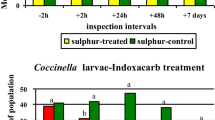Abstract
The susceptibility of adults of the cabbage aphid,Brevicoryne brassicae and two of the most important predators,Coccinella undecimpunctata andChrysopa carnea to pesticides was assessed. Most of the organophosphorus and carbamate compounds tested were toxic to the aphids. Profenophos was highly toxic to the adult virginoparous aphid at Lc50 level. Malathion demonstrated the highest toxicity to, the aphids.
The application of profenophos for the cabbage aphid at Lc50 level exhibited no toxicity forCoccinella but was highly toxic forChrysopa. Pirimicarb proved to be the most selective of the compounds tested for the control of aphids when it was used at a concentration that caused 50% mortality as it was found to be unharmful to bothChrysopa andCoccinella. Dimethoate, on the other hand, was found to be very harmful and highly toxic to bothCoccinella andChrysopa adults and would probably be destructive to those natural enemies in the field.
Laboratory evaluation indicates that both pirimicarb and malathion have potentials for use, in IPM program for vegetable pest control.
Zusammenfassung
Es wurde die Empfindlichkeit der Kohlblattlaus,Brevicoryne brassicae und zwei ihrer wichtigsten räuberischen Feinde, des MarienkäfersCoccinella undecimpunctata und der FlorfliegeChrysopa carnea gegenüber einer Reihe gebräuchlicher Blattlaus-Insektizide im Labor geprüft. Die meisten der getesteten Organophosphorverbindungen und Carbamate waren — auf der Basis der Lc50-Werte — für die Blattlaus toxisch. Profenophos erwies sich für die adulten Virginoparen als sehr toxisch, wurde aber noch wesentlich von Malathion übertroffen.
Profenophos (Lc50) zeigte sich fürCoccinella nicht toxisch, fürChrysopa dagegen hochtoxisch. Pirimicarb war die selektivste der getesteten Insektizide und besaß weder fürCoccinella noch fürChrysopa Giftigkeit. Das andere Extrem bildete als giftigste Verbindung das Dimethoat; es war für beide,Coccinella undChrysopa, hochtoxisch.
Die Laboruntersuchungen ergaben, daß Pirimicarb und Malathion für ein, integriertes Blattlausbekämpfungs-Programm die am besten geeigneten Insektizide sind.
Similar content being viewed by others
References
Abbott, W. S., 1925: A method computing the effectiveness of an insecticide. J. Econ. Ent.18, 265–267.
Adashkevich, A. P.;Kiriyak, G. Y., 1983: The effect of chemical treatments. Zashchita Rast.11, 24.
Finney, D. J., 1971: Probit Analysis. Cambridge Univ. Press, Cambridge 3rd ed. 333 p.
Hassan, S. A.;Klingauf, F.;Shahin, F., 1985: Role ofChrysopa carnea as an aphid predator on sugar beet and the effect of pesticides. Z. ang. Ent.100, 163–174.
Helgeson, R. G.;Tauber, M. J., 1974: Pirimicarb an aphicide nontoxic to three entomophagous arthropods. Environ. Entomol.3, 99–101.
Hellpap, C., 1982: Investigations of the effect of different insecticides on predators of cereal aphids under field conditions. Anz. f. Schädlingsk., Pflanzenschutz, Umweltschutz55, 129–131.
Lecrone, S.;Smilowitz, Z., 1980: Selective toxicity of pirimicarb carbaryl and methamidophos to green peach aphid (Myzus persicae [Sulzer]),Coleomegilla maculata Lengi (Timberlake) andChrysopa oculata Say. Environ. Entomol.9, 752–755.
McDonald, S.;Horper, A. A., 1978: Laboratory evaluation of insecticides for control ofAcyrthosiphon pisum (Hemiptera: Aphididae) in alfalfa. Canad Entom.110, 213–216.
Pree, D. J.;Hagley, E. A. C., 1985: Toxicity of pesticides toChrysopa oculata (Neuroptera: Chrysopidae). J. Econ. Ent.78, 129–132.
Sandhu, G. S., 1986: Chemical control of spotted alfalfa aphidTherioaphis trifolii (Monel) on lucerne with reference to conservation of coccinellid predators. Ind. J. of Plant Prot.13, 125–127.
Upadhay, V. R.;Vyas, H. N., 1986: Comparative toxicity of certain insecticides to predatory coccinellids associated with sucking pests of groundnut in Saurashtra. Ind. J. of Plant Prot.13, 91–93.
Vickerman, G. P.;Sunderland, K. D., 1977: Some effects of dimethoate on arthropods in winter wheat. J. of Appl. Ecol.14, 767–777.
Author information
Authors and Affiliations
Additional information
With 3 tables
Rights and permissions
About this article
Cite this article
Dimetry, N.Z., Marei, S.S. Laboratory evaluation of some pesticides on the cabbage aphid,Brevicoryne brassicae L. and their side effects on some important natural enemies. Anz. Schadlingskde., Pflanzenschutz, Umweltschutz 65, 16–19 (1992). https://doi.org/10.1007/BF01905978
Issue Date:
DOI: https://doi.org/10.1007/BF01905978




